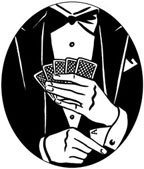Address
453 FDR Dr. #C1107
New York, NY 10002
Phone
(212) 388-0989
email
Joe Hanania
Ace Up Our Sleeve
Public Relations
![]()
Home | Clients | NY Times Articles | NY Magazine | LA Times Articles | TV Guide | Jewish Press
The Best French Pate in America
![]()
As American as Pate (and the French Are Biting)
By JOSEPH HANANIA | Published: October 16, 1996
THINK turkey, cranberry and sweet potato pate. Think vegetarian pate baked in triple-crust pastry. Think paella or even chicken ginger pate.
Increasingly, pate -- the well-seasoned preparation pioneered with ground pork in France during the Middle Ages -- has taken on a distinctive ethnic flavor in the United States. American-made pate is no longer found just in specialty-food shops; it turns up in supermarkets across the country.
Many American pates are still made like their French counterparts, emphasizing pork and goose livers, but companies like Les Trois Petit Cochons (the Three Little Pigs), in Greenwich Village, are also making chicken-based Asian-style pates, with ginger and red pepper; fish and vegetarian pates, geared toward those who do not eat meat, and even a special-order paella pate made with saffron and rice.
All of these pates also have strong crossover appeal, and their segment of the American pate market is among the fastest-growing, the company's owners say.
The American pate industry, which 20 years ago consisted largely of a storefront in New York and one in San Francisco, has seen sales climb to an estimated $15 million a year. Its first manufacturer, Marcel et Henri, set up a store in 1960 on Russian Hill in San Francisco.
Since the store was on the cable-car line, ''lots of tourists also hopped off,'' said Joyce Smith, the director of marketing for Marcel et Henri. One of those tourists was a buyer from Macy's who brought the pate to New York in the late 1960's. The business has since moved to South San Francisco, at 415 Browning Way.
In 1975, Alain Sinturel started Les Trois Petit Cochons at 453 Greenwich Street, near Desbrosses Street. With an estimated $5 million in annual sales now, the company, which makes the turkey, cranberry and sweet potato pate, has become the General Motors of the industry, selling nearly twice as much pate nationwide as Marcel et Henri.
Both companies sell to grocery stores and take telephone orders -- Les Trois Petit Cochons is at (800) 537-7283; Marcel et Henri is at (800) 542-4230 from within California and (800) 227-6436 from elsewhere in the country. A half-dozen smaller pate makers have also set up shop, with headquarters mostly on the East or West Coast.
Because United States Agriculture Department regulations prohibit certain ingredients that are used in France, and because of high shipping costs, only a small amount of the pate consumed in this country is imported from France, and it comes mostly in tins. So, American manufacturers have an open market, said Mr. Sinturel, whose company has received 14 gold and silver medals, the most of any pate maker, from the New York-based National Association for the Specialty Food Trade.
Pate sales have also gained from the industry's adoption of vacuum packing about three years ago. No longer does pate have to be sold by the slice at the deli counter; it can also be sold in small, individualized packets alongside the cheese on supermarket shelves.
At Marcel et Henri, the changes have led to increased sales, which now total more than $3 million a year, Ms. Smith said. ''Most of the new business has come from more rural areas, and from the Midwest and the South,'' she added.
Josette LeBlond, who 10 years ago founded one of the newer pate makers, Normandie Pate, in the Los Angeles area, is taking a cue from her customers. Normandie Pate, which makes 60 different pates, has already reached an estimated $1.8 million in annual sales, largely by giving out samples at area supermarkets and trade shows and then inventing new flavors to accommodate tastes. Its factory is at Gourmet Foods, a distributor, at 2910 East Harcourt Street in Rancho Dominguez, Calif. It sells to grocery stores and takes telephone orders, at (310) 632-3300.
The secret of good pate, especially the foie gras, ''lies in the way the ducks are fed,'' Ms. LeBlond said. ''The ducks must be fed at regular hours. They must not have a stressed, but a regular life. A happy duck is like a happy child.'' And having a happy duck apparently has its rewards. ''Its organs are fresher,'' she said.
Ms. LeBlond, who learned the art of pate making at her father's side in his charcuterie in Evreux, France, does not think that American pates are any poorer than their French counterparts. Many ingredients, including ''le beef,'' are much better here, she said, adding, ''The fiber is more textured, and there is more protein.''
Among her expanding customer base, she said, are Latinos, who make up nearly half of Southern California's population. Mr. Sinturel said that he, too, sees Latin America, especially Mexico and Argentina, as promising areas for sales.
And the newest customers lining up for American pate include some from across the Atlantic. Mr. Sinturel said that a French importer recently expressed an interest in his company's recipes for fusion pates, like couscous with chicken, vegetables, almonds and raisins. For the tradition-bound French, this is ''something novel, something very American,'' he added.
So, will the French buy American pate? Mr. Sinturel laughed. ''It's just a matter of time,'' he said.
©2011 Ace Up Our Sleeve Public Relations
